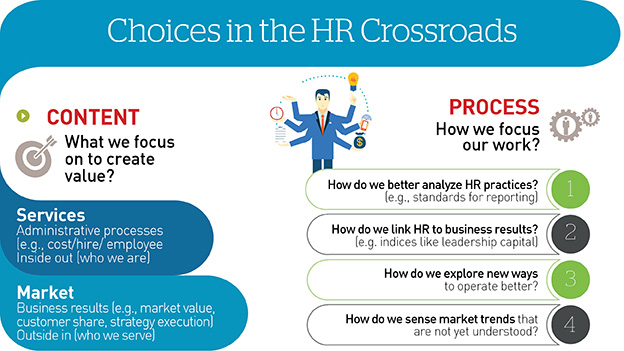HR at a Crossroads

While HR professionals will have more and unique opportunities available to influence, their role will be under increasing scrutiny.
In a world of increased volatility, uncertainty, complexity and ambiguity (VUCA), HR issues matter more than ever.1 The increased relevance of HR functions, practices and professionals to stakeholder outcomes makes this both a great and risky time to be in HR. The good news is that HR professionals have more opportunity to influence business success. The United States’ Conference Board’s 2014 survey of global CEO challenges ranked human capital issues as the number one challenge.2 We have also found that the leadership profile of successful CEOs matches the leadership profile of effective CHROs3, and that HR issues are increasingly a part of firm valuation by thoughtful investors.4 Estimates are that about one-third of the issues discussed at the board level are HR related (e.g., succession planning, talent review, executive compensation, governance, strategy execution, ethics, and culture).
But it is also a riskier time to be in HR because of increased expectations. HR professionals are under more scrutiny than ever to respond as their role takes on a higher profile. When understudies become the lead in a play, when backup players enter a game, or when employees become owners of a company, opportunities for both success and failure increase. Likewise, as HR professionals shift from policy administration, employee transactions, and functional excellence to business outcomes, they will have more and unique opportunities available to have influence. Indeed, HR is at a crossroads. We believe that HR can rise to this occasion and meet these higher expectations. As the role and function of HR continue to evolve, the business world’s perspectives on the field will need to evolve with them. To respond to the new HR opportunities, many HR legacy mindsets that may have been true in the past need to evolve to modern realities.
|
Historical HR myths |
Modern HR realities |
|
|
HR professionals go into HR because they like people. |
HR is not just about liking people, but about understanding and solving people related problems in organizations. In fact, HR often requires tough people choices to assure business results. |
|
|
HR professionals don’t believe in or rely on numbers. |
HR has relied on data for years; now more than ever predictive analytics guide HR decision-making. |
|
|
HR professionals want to get “to the table” where business decisions are made |
HR professionals are now invited to the table; the challenge is knowing what to contribute to stay. |
|
|
HR’s customers are the employees in the company. |
HR’s customers are the customers of the company; HR work helps both internal employees and external customers. |
|
|
HR’s measures of success come from delivering the practices related to HR (eg., staffing, training, compensation, etc.). |
HR is about delivering business results; the scorecard of HR is the business’s scorecard. |
|
|
HR is responsible for the organization’s talent, leadership, and capability. |
Line managers are the primary owners of talent, leadership, and culture; HR professionals are architects who design blueprints and inform choices. |
|
|
HR’s primary role is to keep the organization compliant with laws and regulations. |
Good HR leaders help the organization make good business decisions that match the risk tolerance (or appetite) of the organization. |
To live up to these modern realities, this essay will review [1] the HR crossroads, [2] the emerging outcomes of HR for talent, leadership, and capability, and [3] HR for HR including governance and competencies. In this three-part column, we will be looking at Part I – the HR Crossroads and the subsequent parts will be covered in the next two issues.
HR Crossroads: Content and Process
To respond to these modern realities, HR faces a crossroads with two choices about both content and process. Content choices emphasize where HR will add the most value to the organization. On the one hand, HR value may come from internally focused services, which means managing HR processes more efficiently such as reducing cost per hire per employee. On the other hand, HR value may come from business results, emphasizing how HR delivers shareholder value, customer share, and strategy execution. This crossroads determines how HR professionals define their roles either inside out (who we are) or outside in (who we serve).
Process choices refer to how HR professionals go about doing their work. Based on work by national security expert Gregory Treverton and amplified by author Malcolm Gladwell, decisions can be made through puzzle solving or mystery exploration. In HR today, analytics play an increasing role. Puzzle solving is being an architect who builds blueprints that guide how to build the right house for the owner. Good architects turn owners’ lifetsyles into blueprints and eventually residences. Mystery exploration is being an anthropologist who thoughtfully observes the world to discover what people do. Anthropologists find order in chaos; they interpret and organize unrelated issues into patterns that can be explained.
HR architects are puzzle solvers; HR anthropologists are mystery investigators. Puzzle solving analytics focus on the science of HR, with frameworks, spreadsheets, and analytics. Mystery seeking analytics focuses on the art of HR, with observations, perceptions, and insights. Puzzles focus on answers; mysteries on questions. Puzzles solve problems; mysteries define them. Puzzles offer certainty; mysteries encourage curiosity. Puzzles imply that HR professionals are architects doing design work; mysteries imply HR professionals are anthropologists observing patterns.
Putting the content and process choices together, we can identify four options in the HR crossroads:

Often HR future falls into cell 1 where we seek standards and consistency in reporting HR services such as scorecards and standards. More recently, work on linking HR to business results has moved into cell 2 where things like the leadership capital index become mechanisms to define HR value where HR links to external business realities. We envision more work in cell 3 where HR professionals probe new ways to operate better inside the organization. This work might include innovations in thinking about employee engagement/well being and organization capability/culture. Cell 4 comes when HR professionals co create outside in perspectives on HR value added posing new questions and seeking new answers. With these crossroads in mind, we can look at the outcomes of HR and how they evolve as HR professionals seeking to deliver value from the outside in through defining mysteries (cell 3 and 4).
Outside in thinking means that HR aligns HR practices to customers, investors, and other external community stakeholders. Outside-in HR is based on the premise that the business of HR is the business. Outside in logic goes beyond the current state of the HR profession, where the focus is on connecting strategy to HR. We now believe that rather than a mirror in which HR practices are reflected, business strategy should be regarded as a window through which HR professionals observe, interpret, and translate external conditions and stakeholder expectations into internal actions.
In the next issue, we will cover the ‘Emerging outcomes of HR for talent, leadership and capability.
References
1. This premise of HR mattering more in times of uncertainty was actually tested. We correlated the impact of investing in HR on firm performance. In times of change, HR mattered more than in times of stability.
2. The Conference Board CEO Challenge 2014. (www.ceochallenge.org)
3. Dave Ulrich and Ellie Filler, “CEOs and CHROs: Crucial Allies and Potential Successors,” published by the Korn Ferry Institute, 2014; also to be published in Leader to Leader.
4. Dave Ulrich, Leadership Capital Index (forthcoming 2015); Laurie Bassi, David Creelman, and Andrew Lambert, “The Smarter Annual Report: How Companies Are Integrating Financial and Human Capital Reporting,” Creelman Lambert and McBassi & Company, 2014.














